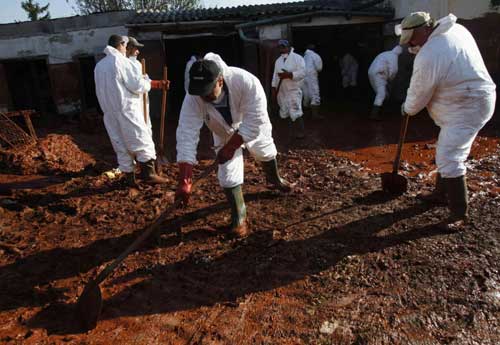World
Toxic Hungarian sludge spill reaches River Danube
(Agencies)
Updated: 2010-10-08 08:24
 |
Large Medium Small |
GYOR, Hungary - Toxic red sludge from a Hungarian alumina plant reached the Danube on Thursday and crews struggled to dilute it to protect the river from what the prime minister called an "unprecedented ecological catastrophe".
Experts said damage beyond the borders of Hungary was unlikely to be great but the threat had to be monitored closely.
Tibor Dobson, a spokesman for Hungarian disaster crews, told Reuters there were sporadic fish deaths in the Raba and the Mosoni-Danube rivers. He said all fish had died in the smaller Marcal River, which was hit by the spill first.
Crews were working to reduce the alkalinity of the spill, which poured out of the burst containment reservoir of an alumina plant on Monday and tore through local villages, killing four people and injuring over 150. Three are still missing.
The spill's alkaline content when it reached the Raba, the Mosoni-Danube and the Danube itself, was still around pH 9 -- above the normal, harmless level of between 6 and 8.
Fresh data from the water authority on national news agency MTI showed pH levels peaking at 9.65 in the Mosoni-Danube river at the city of Gyor. They were measured at 8.4 in the Danube.
Crews were puring hundreds of tonnes of plaster and acetic acid into the rivers to neutralise the alkalinity.
In Gyor, a city in the northwest of Hungary where the Raba flows into the Mosoni-Danube, a Reuters reporter saw white froth on the river and many dead fish washed ashore.
Philip Weller, executive secretary to the International Commission for the Protection of the Danube River (ICPDR), a Vienna-based UN body, said most damage was local.
"It is clear that the consequences of this are greatest in the local area and that the implications on a trans-boundary level, we understand, will not be significant which doesn't mean they don't exist," he said.
"The Hungarian authorities took a number of measures to reduce the toxicity, they added substances to neutralise the material, they also constructed some underwater weirs to slow the mud and maintain it and contain it as much as possible in the Hungarian territory of the river system."
It also helps that the Danube is a large river with a very high volume of water, he added.
Gabor Figeczky, Hungarian branch director of the WWF environmental group said:
"Based on our current estimates, it (pollution) will remain contained in Hungary, and we also trust that it will reach Budapest with acceptable pH values."
Downstream from the disaster site, the Danube flows through or skirts Croatian, Serbian, Bulgarian, Romanian, Moldovan and Ukrainian territory en route to the Black Sea.
Hungary declared a state of emergency in three counties on Tuesday after the torrent of caustic waste sludge from bauxite refining hit Kolontar, Devecser and other villages 160 km (100 miles) west of Budapest.
Prime Minister Viktor Orban visited Kolontar on Thursday and said there was no point in even removing the rubble from part of the village as it was impossible to live there again.
"It is difficult to find the words. Had this happened at night, everybody would be dead," he told reporters.
